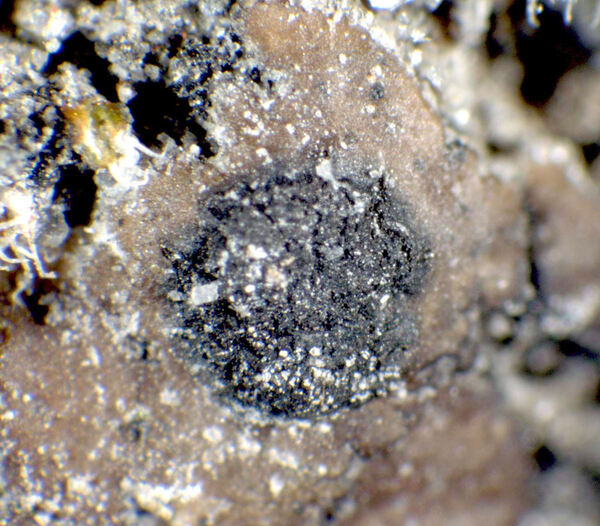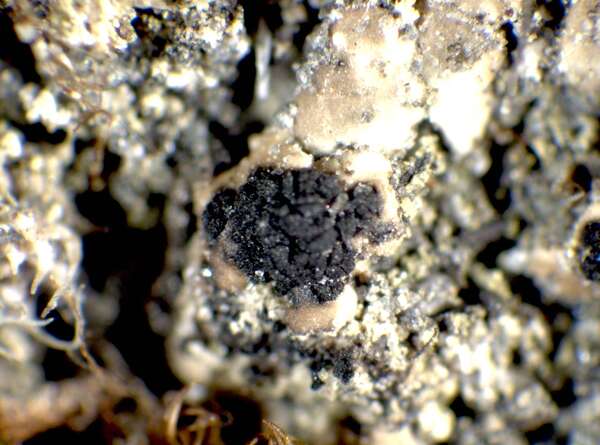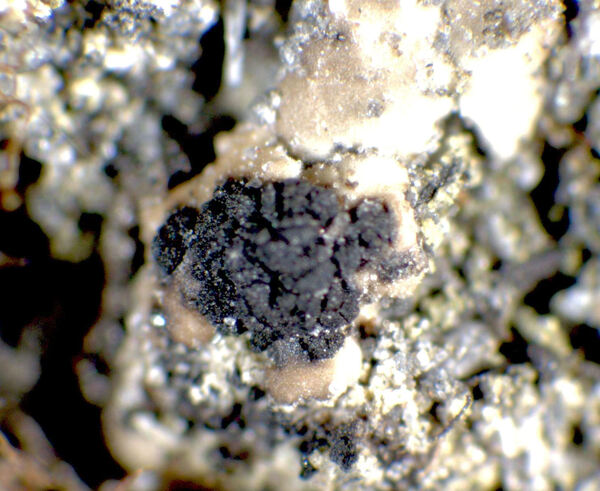Opegrapha pulvinata Rehm
in Lojka, Verh. zool.-bot. Ges. Wien, 19: 500, 1869.
Synonyms: Leciographa pulvinata (Rehm) Arnold; Trematosphaeria dermatocarponis Werner; Trematosphaeria lophiostoma Werner & M. Choisy
Description: Thallus inapparent, not lichenized, parasitic on the thalli of foliose or squamulose pyrenocarpous lichens. Apothecia lirelliform, black, partly immersed in the host thallus or finally adnate, 0.2-0.5 x 0.1-0.3 mm, straight or curved, with a slit-like disc, and a sometimes white-pruinose raised margin, aggregated in up to 3(-4) mm wide, dense clusters. Proper exciple black, carbonized, extending below the hymenium, K+ brownish; hymenium colourless to pale yellowish brown, 100-110 µm high, I+ persistently blue in upper part; paraphysoids branched and anastomosing, 2.5-3 µm thick, the apical cells hardly swollen; hypothecium pale brown, 12-25 µm high. Asci 8-spored, broadly club-shaped, the inner layer of endoascus amyloid in upper part, with a reduced I+ blue ring surrounding a small ocular chamber, Varia-type. Ascospores 3-septate, at first hyaline, then soon turning brown, ellipsoid to oblong-ovoid, straight, (18-)20-24(-26) x 6-8 µm, surrounded by a thick gelatinous sheath, the pigment of the overmature ones located in the wall, without dark granules in the perispore. Pycnidia black, immersed. Conidia bacilliform, straight, 5-7 x 1 µm. Photobiont absent. Spot tests: all negative. Chemistry: without lichen substances.
Growth form: Lichenicolous fungus
Substrata: soil, terricolous mosses, and plant debris
Reproductive strategy: mainly sexual
paras foliose or squamulose pyrenocarpous lichens
Commonnes-rarity: (info)
Alpine belt: absent
Subalpine belt: absent
Montane belt: very rare
Dry submediterranean belt: very rare
Humid submediterranean belt: very rare
Padanian area: absent
pH of the substrata:
1 2 3 4 5
Solar irradiation:
1 2 3 4 5
Aridity:
1 2 3 4 5
Eutrophication:
1 2 3 4 5
Poleotolerance:
0 1 2 3
Altitudinal distribution:
1 2 3 4 5 6
Rarity
absent
extremely rare
very rare
rare
rather rare
rather common
common
very common
extremely common
Loading data...
Occurrence data
Predictive map
Growth form: Lichenicolous fungus
Substrata: soil, terricolous mosses, and plant debris
Reproductive strategy: mainly sexual
paras foliose or squamulose pyrenocarpous lichens
Commonnes-rarity: (info)
Alpine belt: absent
Subalpine belt: absent
Montane belt: very rare
Dry submediterranean belt: very rare
Humid submediterranean belt: very rare
Padanian area: absent
pH of the substrata:
| 1 | 2 | 3 | 4 | 5 |
Solar irradiation:
| 1 | 2 | 3 | 4 | 5 |
Aridity:
| 1 | 2 | 3 | 4 | 5 |
Eutrophication:
| 1 | 2 | 3 | 4 | 5 |
Poleotolerance:
| 0 | 1 | 2 | 3 |
Altitudinal distribution:
| 1 | 2 | 3 | 4 | 5 | 6 |
Rarity
absent
extremely rare
very rare
rare
rather rare
rather common
common
very common
extremely common
Loading data...
Occurrence data
Predictive map









